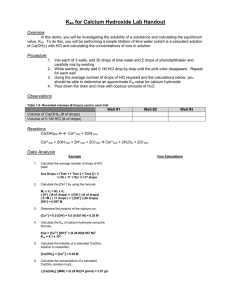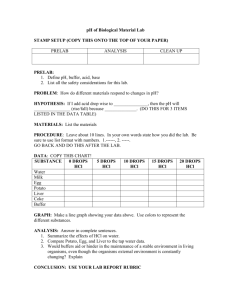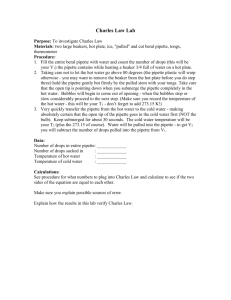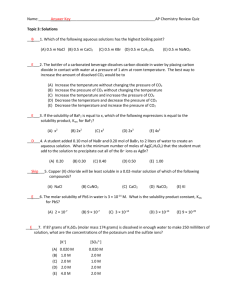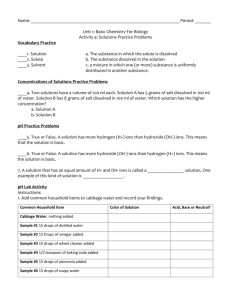Ksp of Calcium Hydroxide
advertisement
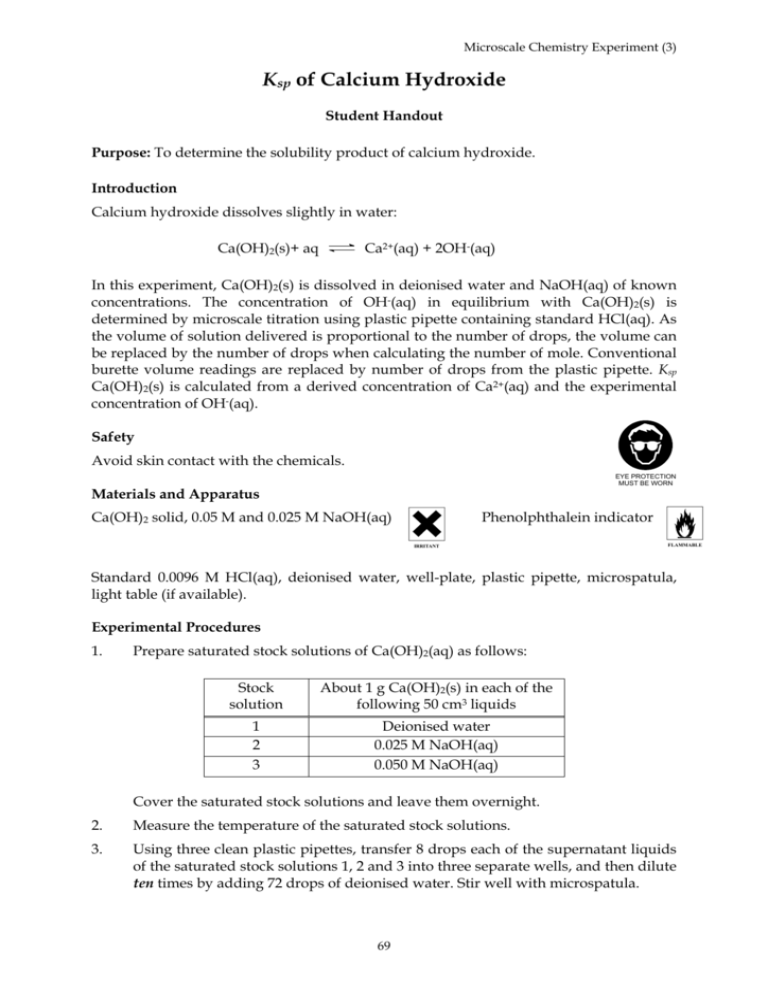
Microscale Chemistry Experiment (3) Ksp of Calcium Hydroxide Student Handout Purpose: To determine the solubility product of calcium hydroxide. Introduction Calcium hydroxide dissolves slightly in water: Ca(OH)2(s)+ aq Ca2+(aq) + 2OH-(aq) In this experiment, Ca(OH)2(s) is dissolved in deionised water and NaOH(aq) of known concentrations. The concentration of OH-(aq) in equilibrium with Ca(OH)2(s) is determined by microscale titration using plastic pipette containing standard HCl(aq). As the volume of solution delivered is proportional to the number of drops, the volume can be replaced by the number of drops when calculating the number of mole. Conventional burette volume readings are replaced by number of drops from the plastic pipette. Ksp Ca(OH)2(s) is calculated from a derived concentration of Ca2+(aq) and the experimental concentration of OH-(aq). Safety Avoid skin contact with the chemicals. EYE PROTECTION MUST BE WORN Materials and Apparatus Phenolphthalein indicator Ca(OH)2 solid, 0.05 M and 0.025 M NaOH(aq) IRRITANT FLAMMABLE Standard 0.0096 M HCl(aq), deionised water, well-plate, plastic pipette, microspatula, light table (if available). Experimental Procedures 1. Prepare saturated stock solutions of Ca(OH)2(aq) as follows: Stock solution About 1 g Ca(OH)2(s) in each of the following 50 cm3 liquids 1 2 3 Deionised water 0.025 M NaOH(aq) 0.050 M NaOH(aq) Cover the saturated stock solutions and leave them overnight. 2. Measure the temperature of the saturated stock solutions. 3. Using three clean plastic pipettes, transfer 8 drops each of the supernatant liquids of the saturated stock solutions 1, 2 and 3 into three separate wells, and then dilute ten times by adding 72 drops of deionised water. Stir well with microspatula. 69 Microscale Chemistry Experiment (3) 4. Place the well-plate on a light table (if available). Using a clean plastic pipette, transfer 25 drops of the diluted solution 1 into a well of the well-plate. Add one drop of phenolphthalein indicator. Clean and wash the same plastic pipette with deionised water. Rinse and fill the plastic pipette with 0.0096 M HCl(aq). Carefully titrate the diluted solution 1 (see Fig. 1) by adding drops of 0.0096 M HCl(aq) solution from the plastic pipette until the red colour is discharged. Occasionally stir the solution. Record the number of drops of 0.0096 M HCl(aq) added. 5. Repeat step (4) with the diluted stock solutions 2 and 3. Fig. 1: Microscale titration Results Temperature = _______ oC Stock solution No. of drops of 0.0096M HCl (aq) used 1 2 3 Original conc. of OH-(aq) / mol dm-3 10-7 0.025 0.050 Treatment of Data Calculate the concentration of Ca2+(aq) in the stock solutions 1, 2 and 3 and complete the following table. Stock solution [Ca2+(aq)] / mol dm-3 [OH-(aq)] / mol dm-3 1 2 3 70 Ksp = [Ca2+(aq)] [OH-(aq)]2 / mol3 dm-9 Microscale Chemistry Experiment (3) Discussion Questions 1. Write down the expression for the Ksp of calcium hydroxide. 2. Explain the variation in concentration of Ca2+(aq) in the saturated Ca(OH)2 solutions as the concentration of OH-(aq) increases. 3. Calculate an average value of Ksp of calcium hydroxide and compare with the literature value from a data book. Comment on the discrepancy, if any. 71
